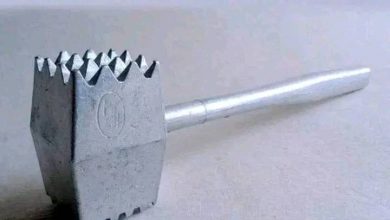The Mystery of the Strange Tool: Unveiling Its True Purpose**

ADVERTISEMENT
The Mystery of the Strange Tool: Unveiling Its True Purpose**
In an age where curious and often humorous discoveries can be shared instantly, an unusual find in a family member’s drawer can quickly spark intrigue and concern. The image of a peculiar metal tool found in a dad’s drawer, accompanied by the caption “Is it what I am afraid of?”, highlights the blend of curiosity and anxiety that such discoveries can provoke. Let’s explore what this tool is and unravel its true purpose.
Identifying the Mysterious Tool
ADVERTISEMENT
At first glance, the metal object in the image might look like a medical instrument, conjuring up all sorts of scenarios. However, its actual use is far less alarming and is rooted in practical, everyday applications.
The Dental Key: A Historical Perspective
The tool in question is known as a dental key, a device used historically in dentistry. The dental key was a common instrument in the 18th and early 19th centuries, used for extracting teeth. It resembles a modern-day corkscrew, with a handle and a metal shaft that ends in a claw-like grip.
How the Dental Key Was Used
1. **Positioning**: The dental key was positioned over the tooth to be extracted, with the claw placed around the tooth.
2. **Rotation**: The handle was then turned, much like a key in a lock, to grip the tooth firmly.
3. **Extraction**: Continued turning would pull the tooth from its socket. This process was often painful and could lead to complications.
ADVERTISEMENT
Evolution of Dental Tools
Thankfully, dentistry has evolved significantly since the days of the dental key. Modern dental practices use more sophisticated and humane methods for tooth extraction, involving anesthesia and precision instruments that minimize pain and risk.
The Importance of Historical Artifacts
While the dental key might seem like a terrifying artifact today, it serves as an important reminder of the progress in medical and dental practices. Collectors and historians value these tools for the insights they provide into the history of medicine and the challenges faced by practitioners of the past.
What to Do if You Find a Strange Tool
ADVERTISEMENT
If you come across an unusual tool like the dental key, here are a few steps to help identify it:
1. **Research**: Look up images and descriptions of old tools and medical instruments online. Websites dedicated to historical artifacts can be particularly helpful.
2. **Ask Experts**: Reach out to museums, historical societies, or online forums where experts in antique tools and medical history might be able to provide information.
3. **Preserve the Item**: Keep the item in a safe place. Historical tools can be fragile, and preserving them in good condition is important for historical records.
Conclusion
The discovery of a strange tool in a family drawer can lead to a mix of humor, curiosity, and a bit of alarm. However, by investigating and understanding the true purpose of these artifacts, we can appreciate their historical significance and the advancements that have made modern life more comfortable and safe. The dental key, once a common sight in dental practices, now stands as a testament to how far we’ve come in medical science.
ADVERTISEMENT
—
Feel free to customize this article further or let me know if you need additional information or another topic!




